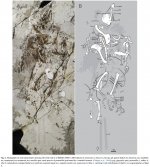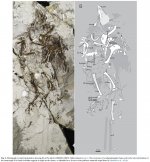Fred Ruhe
Well-known member

Guillermo Navalón, Qingjin Meng, Jesús Marugán-Lobón, Yuguang Zhang, Baopeng Wang, Hai Xing, Di Liu, Luis M. Chiappe, 2018
Diversity and evolution of the Confuciusornithidae: Evidence from a new 131-million-year-old specimen from the Huajiying Formation in NE China
Journal of Asian Earth Sciences 152 (2018) 12–22
Abstract:
The Huajiying Formation contains the earliest deposits of the Jehol Biota, representing the world’s second oldest avifauna. This avifauna includes the early confuciusornithid Eoconfuciusornis zhengi, the oldest occurrence of this clade and one of the earliest divergences of pygostylian birds. Although E. zhengi shows unique traits, the holotype’s immature age makes comparisons with the better known Confuciusornis sanctus problematic. As a result, the taxonomic validity of E. zhengi is controversial. We describe a small, osteologically adult confuciusornithid from the same deposits as E. zhengi. The new fossil is most similar to E. zhengi but also shares traits with the stratigraphically younger Confuciusornis. The humerus of the new fossil is straighter and more slender, and bears a less dorsally-developed deltopectoral crest compared with similarly-sized and smaller specimens of Confuciusornis. The morphology of the humerus is intermediate between E. zhengi and Confuciusornis and its proximal portion is pierced by a small deltopectoral foramen, absent in the holotype of E. zhengi. However, this foramen is much smaller than in any other confuciusornithid. Shape analyses (geometric morphometrics) of the humerus of confuciusornithids of different ages and representatives of other basal avians and closely-related non-avian theropods supports our observations and indicate that the humeral differences between the holotype of E. zhengi and the new specimen are not easily explained as ontogenetic variation within a single species. However, the limited number of early confuciursornithids does not allow us to confidently interpret such differences as interspecific. Nonetheless, these analyses support the morphological distinctiveness of the early confuciusornithids from the Huajiying Formation and suggest a stepwise acquisition of the unique humeral morphology of Confuciusornithidae.
Free pdf https://www.researchgate.net/public...imen_from_the_Huajiying_Formation_in_NE_China
Enjoy,
Fred
Diversity and evolution of the Confuciusornithidae: Evidence from a new 131-million-year-old specimen from the Huajiying Formation in NE China
Journal of Asian Earth Sciences 152 (2018) 12–22
Abstract:
The Huajiying Formation contains the earliest deposits of the Jehol Biota, representing the world’s second oldest avifauna. This avifauna includes the early confuciusornithid Eoconfuciusornis zhengi, the oldest occurrence of this clade and one of the earliest divergences of pygostylian birds. Although E. zhengi shows unique traits, the holotype’s immature age makes comparisons with the better known Confuciusornis sanctus problematic. As a result, the taxonomic validity of E. zhengi is controversial. We describe a small, osteologically adult confuciusornithid from the same deposits as E. zhengi. The new fossil is most similar to E. zhengi but also shares traits with the stratigraphically younger Confuciusornis. The humerus of the new fossil is straighter and more slender, and bears a less dorsally-developed deltopectoral crest compared with similarly-sized and smaller specimens of Confuciusornis. The morphology of the humerus is intermediate between E. zhengi and Confuciusornis and its proximal portion is pierced by a small deltopectoral foramen, absent in the holotype of E. zhengi. However, this foramen is much smaller than in any other confuciusornithid. Shape analyses (geometric morphometrics) of the humerus of confuciusornithids of different ages and representatives of other basal avians and closely-related non-avian theropods supports our observations and indicate that the humeral differences between the holotype of E. zhengi and the new specimen are not easily explained as ontogenetic variation within a single species. However, the limited number of early confuciursornithids does not allow us to confidently interpret such differences as interspecific. Nonetheless, these analyses support the morphological distinctiveness of the early confuciusornithids from the Huajiying Formation and suggest a stepwise acquisition of the unique humeral morphology of Confuciusornithidae.
Free pdf https://www.researchgate.net/public...imen_from_the_Huajiying_Formation_in_NE_China
Enjoy,
Fred





